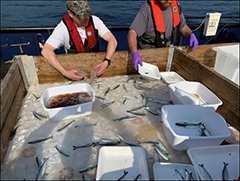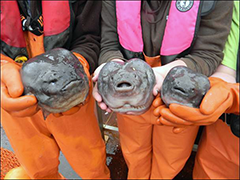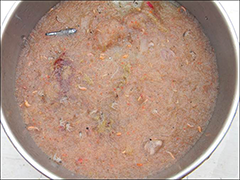Commercial Salmon Fisheries
Southeast Alaska & Yakutat Research: Southeast Alaska Coastal Monitoring (SECM)

Figure 1. — Click for more Info

Figure 2. — Click for more Info

Figure 3. — Click for more Info

Figure 4. — Click for more Info

Figure 5. — Click for more Info

Figure 6. — Click for more Info

Figure 7. — Click for more Info

Figure 8. — Click for more Info

Figure 9. — Click for more Info

Figure 10. — Click for more Info
Introduction
NOAA Alaska Fisheries Science Center, Auke Bay Laboratories initiated the Southeast Alaska Coastal Monitoring (SECM) survey in 1997 to identify relationships between the year-class strength of juvenile salmon and the biophysical parameters influencing: 1) growth and survival, 2) prey and predator interactions, 3) habitat utilization, and 4) stock interactions in marine waters. These surveys support research on the marine ecology and production dynamics of Southeast Alaska salmon stocks and provide juvenile abundance and ecosystem metrics that produce the harvest forecast models for pink salmon. The initial marine period for salmon translates to high and variable mortality and is believed to be the primary determinant of year-class strength. SECM surveys provide unique insight into the relative importance of the initial and later marine stages of salmon to their overall survival by sampling juveniles after the initial marine entry stage. A major finding of the SECM survey is that relative abundance of juvenile pink salmon in June and July is highly correlated to harvest of adults in the subsequent year; this information has since been the key component of NOAA and ADF&G pink salmon forecasts. Since 2018, ADF&G and NOAA scientists collaborate to create a joint preseason pink salmon harvest forecast and the SECM survey is now conducted cooperatively by NOAA and ADF&G using the ADF&G research vessel Medeia (Figure 1).
A tremendous amount of data is collected on each survey and includes juvenile salmon catch per unit effort (proxy of abundance), size, condition, and diet. Juvenile chum, sockeye, coho, and Chinook salmon are also sampled for coded wire tags, otolith marks, or genetics to provide stock composition for those species (Figure 2). These data are also collected from immature and maturing salmon captured during the survey. In addition, all other pelagic fish species captured during the survey are counted, weighed, and potentially sampled for diet and other biological information depending on species and data requests from other projects and researchers. Even jellyfish captured during the survey are identified to species, weighed, and occasionally specimens are collected for other researchers studying these species. Zooplankton, an important food source for juvenile salmon, are also sampled to provide information on prey abundance, composition, and quality in Southeast Alaska. Additional oceanography data are collected during the survey such as water temperature, salinity, and surface phytoplankton samples.
Study Area
Primary sampling stations are within the inshore waters of northern Southeast Alaska and extend from Stephens Passage to Icy Strait (Figure 3). Data from four sampling stations located near the junction of upper Chatham Strait and Icy Strait, and four stations located in Icy Strait just north of the city of Hoonah are used in the annual preseason pink salmon harvest forecast, as well as a variety of other assessments. Icy Strait is one of the primary migration corridors for juvenile salmon heading to sea from the inside waters of northern Southeast Alaska. Four additional sampling stations located in Stephens Passage, along the southern shore of Douglas Island, provide data on juvenile Chinook salmon, primarily from the Taku River and local hatchery releases. In the past, additional stations have been sampled for one or more years, including locations in Clarence Strait, lower Chatham Strait, Sumner Strait, a variety of stations in the passages near the mouth of the Stikine River, and offshore locations west of Icy Strait and Cross Sound.
Pelagic Trawls
A Nordic 264 rope trawl net, with an opening approximately 18 by 24 meters when fully deployed, is used to conduct surface trawls (Figure 4). Once the net is brought up to the vessel, the catch is initially sorted by species and life-history stage in preparation for further sampling (Figure 5).
Identification of salmon during their first few months at sea can be extremely challenging (Figure 6). The physical traits and field marks used to identify juvenile salmon in freshwater are often faded, modified, or are no longer present. Juveniles of the same species occurring in a single trawl may have diverse appearances due to variations in development and time at sea. In addition, many of the distinguishing characteristics and field marks that can be used to identify adult salmon are not present in juvenile salmon during their first few months at sea. Due to the difficulty in early marine juvenile salmon identification, multiple features are used when distinguishing between species.
A variety of other species may be encountered during SECM surveys. Some of the most common species include Pacific herring, walleye pollock, starry flounder, Pacific spiny lumpsucker, smooth lumpsucker (Figure 7), crested sculpin, soft sculpin, Pacific sandfish, and prowfish. Among the most exciting catches on the survey are the occasional salmon shark (Figure 8).
Zooplankton Sampling
Oceanographic data are collected once at each station during the survey and sampling for zooplankton is a key part of this effort. Zooplankton are the animal component of the plankton community and are comprised of a broad diversity of small organisms found in the water column. They are a primary food source for juvenile salmon and other pelagic fishes. Zooplankton are sampled with a bongo net, which has two parallel nets with different mesh sizes to capture different sizes of zooplankton (Figures 9 and 10). Among the prey species for juvenile salmon in Southeast Alaska are calanoid copepods, euphausiids (krill), oikopleurans, decapod larvae (crabs, shrimp, etc.), larvaceans, amphipods, and pteropods. Zooplankton samples tell us about food availability and quality for juvenile salmon as they move through the inside waters of northern Southeast Alaska on their way to the Pacific Ocean.
Information provided by the SECM survey on zooplankton density and nutritional quality trends in Icy Strait, as well as juvenile salmon abundance, size, and condition can be found as part of larger ecosystem status reports found here: Ecosystem Status Reports For The Gulf Of Alaska, Bering Sea And Aleutian Islands | NOAA Fisheries.
Selected Publications
- Operational Plan: Southeast coastal monitoring, 2021. (PDF)
- Southeast Alaska pink salmon forecasting models. (PDF)
- Southeast Alaska Pink Salmon Growth and Harvest Forecast Models (PDF)
- Southeast Alaska Coastal Monitoring Survey: Salmon Distribution, Abundance, Size, and Origin, 2020. (PDF)
- Southeast Alaska Coastal Monitoring Survey May–July 2021. (PDF)
- Southeast Alaska Coastal Monitoring Survey: Salmon Trophic Ecology and Bioenergetics, 2020 (PDF)
- Trophic responses of juvenile Pacific salmon to warm and cool periods within inside marine waters of Southeast Alaska. (PDF)
- Full article: Diets and Trophic Linkages of Epipelagic Fish Predators in Coastal Southeast Alaska during a Period of Warm and Cold Climate Years, 1997–2011. (PDF)
- Biological Monitoring of Key Salmon Populations: Southeast Alaska Pink Salmon. (PDF)
- Diel Feeding and Gastric Evacuation of Juvenile Pink and Chum Salmon in Icy Strait, Southeastern Alaska, May–September 2001. (PDF)
Additional reports from NOAA on the SECM survey can be found at Southeast Alaska Coastal Monitoring Survey Reports | NOAA Fisheries.
